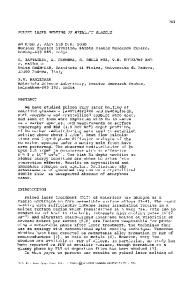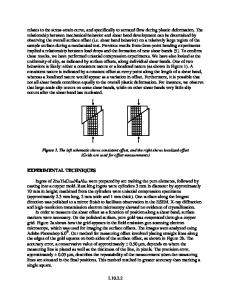Shear deformation capability of different metallic glasses
- PDF / 533,207 Bytes
- 6 Pages / 612 x 792 pts (letter) Page_size
- 110 Downloads / 428 Views
J. Shen School of Materials Science and Engineering, Harbin Institute of Technology, Harbin 150001, China
S.X. Mao Shenyang National Laboratory for Materials Science, Institute of Metal Research, Chinese Academy of Sciences, Shenyang 110016, China; and Department of Mechanical Engineering and Materials Science, University of Pittsburgh, Pittsburgh, Pennsylvania 15261 (Received 10 March 2008; accepted 19 June 2008)
The mechanical properties of Zr52.5Ni14.6Al10Cu17.9Ti5 and Ti40Zr25Ni3Cu12Be20 metallic glasses were investigated under uniaxial compressive loading and small punch loading, respectively. The Zr-based metallic glass displays higher density of shear bands, larger critical shear offsets and higher energy absorbing capability than the Ti-based metallic glass under the small punch tests. A concept of critical shear offset is proposed to explain the difference in shear deformation abilities or plasticity of different metallic glasses. The current experiments demonstrate that, in contrast with the small difference between the responses of the Zr- and Ti-based metallic glasses under uniaxial compressive loading, the biaxial tension produced by the small punch test is an effective way to evaluate the difference in shear deformation abilities and can be used to distinguish the brittleness or plasticity of various metallic glasses. I. INTRODUCTION
Plastic deformation in metallic glasses (MGs) is still a mystery despite being well investigated.1–4 Under uniaxial tension, because there are no grain boundaries to stop the fast propagating of shear bands, MGs fail catastrophically, exhibiting near-zero macroscopic plasticity, although the shear band itself has a high microscopic plasticity, up to 102–104%.5,6 Under uniaxial compression are also few shear bands, and the specimen fails rapidly by propagation of an individual shear band, displaying only limited plasticity (usually smaller than 2%).7,8 Although the bending test is considered an inherently stable deformation method because the stress to drive shear bands diminishes gradually as the shear band approaches the neutral axis,9,10 the ductility-underbending test can be achieved only if the specimen’s dimensions are below a critical value, suggesting a strong size effect on the bending ductility.11,12 In addition, indentation—especially instrument-driven nanoindentation—has been used extensively to study the evolution of shear bands and plastic deformation instability, i.e., ser-
II. EXPERIMENTAL
a)
Address all correspondence to this author. e-mail: [email protected] DOI: 10.1557/JMR.2008.0325 2662
rated flow behavior, in MGs.13–15 It was found that dense and regular shear bands were often formed in the region beneath the indenter,16,17 which is intuitive in understanding the shear band morphology and is useful to investigate the plastic deformation behavior of MGs. In contrast to the catastrophic shear failure under uniaxial compression, MG can display a large inelastic deformation of more than 10% with more shear bands due to confined loading, demonstrat
Data Loading...











